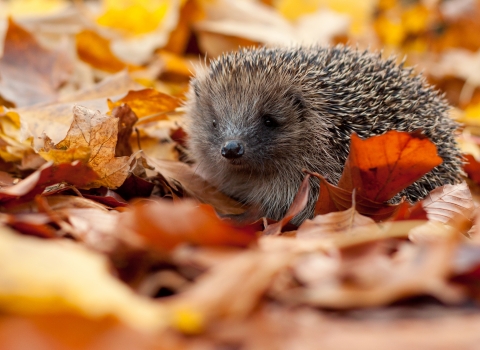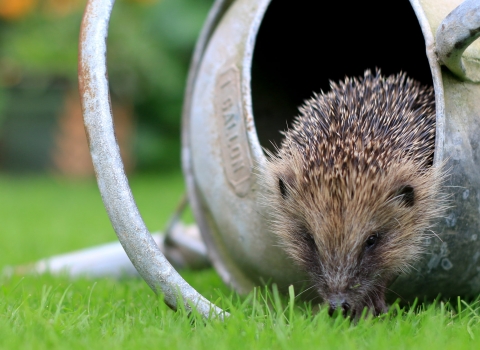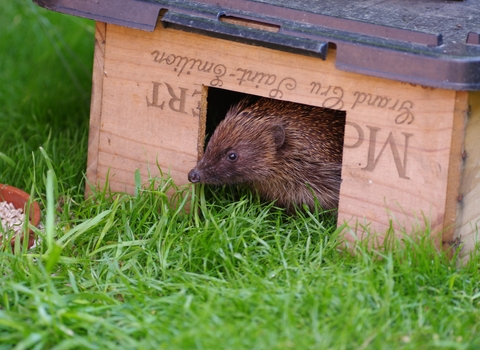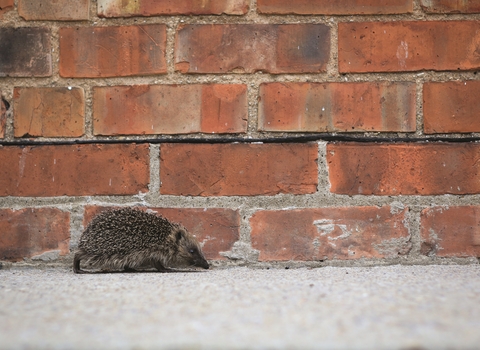From advice on what you should do if you see a hedgehog out during the day to if they can give household pets fleas, there is plenty of advice below on some frequently asked questions about hedgehogs below.
What should I do if I see a hedgehog out in the daytime?
Hedgehogs are nocturnal, so a hedgehog seen out during the day may be suffering from an illness. Please be aware that although unusual, during a lean summer a female hedgehog may make daytime foraging trips to secure enough food to feed her hoglets - removing the female would jeopardise their survival.
If you are concerned, please seek advice from a rescue centre. Details of hedgehog rescue centres can be found here.
Do hedgehogs hibernate?
Although many species are less active over winter in the UK, only three enter true hibernation: hazel dormice, our native bats and hedgehogs.
Depending on the weather and their body condition, they usually hibernate from around November through to March or April depending on the weather. Research has shown that they're may move nesting sites at least once during this period, so if you spot one out and about it may be that they need food, or they might just be looking for a new spot to nest.
Log and leaf piles are one of their favourite places to nest and hibernate, so please do read the tips below for how to check bonfires for hedgehogs before lighting them.
How can I check my bonfire for hedgehogs?
- If you're building a bonfire, build it on the same day that you will light it. The longer it’s left for, the more likely it is that a hedgehog will wander in
- Place chicken wire one metre high at an outward angle all the way around the bottom while you're building
- If you have stored materials for your bonfire outdoors, then move them to a different patch of ground
- Always place the bonfire on open ground – never on a pile of leaves as a hedgehog may be hiding underneath
- Always check the entire bonfire for hedgehogs before lighting it - they tend to hide in the centre and bottom two feet in particular
- When checking, lift parts of the bonfire section by section using a pole or broom - using a fork, spade or rake can injure them so don't use them
- Use a torch to look inside the bonfire and listen for a hissing sound, as this is the noise that hedgehogs make when they are disturbed or distressed
- Always light your bonfire from one corner rather than in the centre in order to give hedgehogs a chance to escape if they need to
If you do find a hedgehog then move slowly and calmly. Pick it up with gardening gloves, along with any nesting material it may have been sitting in, and place it in a cardboard box lined with newspaper. Relocate the box to a safe location that is far from any fires or wait until the bonfire is over and dampen down the fire site with water before releasing the hedgehog under a bush or a log pile.
You can find more tips on what to do if you find an injured hedgehog on our wildlife advice page.
Can I move a hibernating hedgehog?
By moving a hibernating hedgehog, you are at risk of waking it, and therefore using up a large quantity of their fat store which they need to make it through the winter. Please leave a hibernating hedgehog alone unless absolutely necessary.
If you do disturb a nest accidentally, cover the hedgehog back up with leaves and retreat. Make sure some food is available nearby so that if the hedgehog does awaken it has some food to help it regain its stores before it goes back into hibernation. For further advice please contact your local rescue centre.
What should I do if I see a hedgehog in the winter?
If a hedgehog is out during the day in winter, it should be rescued regardless of its weight. If you see a hedgehog at night, it should only be rescued if it looks particularly skinny as research has shown that they may move nesting sites at least once during their hibernation period.
It can cause unnecessary stress to the hedgehog if it is taken to a rescue centre needlessly. If you are concerned about a hedgehog, please contact your local hedgehog advice centre.
What should I do if I have a hedgehog sleeping on my lawn?
Hedgehogs sleep and hibernate in a specially made nest, if you find them 'sleeping' anywhere else it's likely that they are ill and are in need of help. For advice, please contact your local hedgehog rescue centre.
How can I encourage hedgehogs?
There are many easy, quick, and cheap ways that you can encourage hedgehogs, from building hedgehog homes to being a little less tidy with your gardening.
The best way to encourage hedgehogs is to actually allow them into your garden! Make sure you have a hole in your boundary fence or a gap under a gate which is at least a CD-sided hole for a hedgehog to fit through. You can find out more about how to create a hedgehog hole here.
What do they eat and can I feed them?
Hedgehogs eat a variety of insects, molluscs and other invertebrates, often switching from one food type to the other depending on the time of year. Beetles, earthworms and caterpillars make up most of their diet, but you can provide food to support them as they fatten up for hibernation.
You can feed them non fish-based cat food or bird food and water. Do not give them bread and milk as it will make them ill and can even be fatal. Hedgehogs are lactose intolerant, so at best milk will severely upset their stomachs. Bread holds very little nutritional value meaning they’ll fill up on food which will not help them in the long run.
Cat or dog food is a good food to offer, as are some of the ready packaged hedgehog foods you can buy in pet stores and supermarkets. Of course, the best food you can provide is the natural snack bar which comes from a hedgehog-friendly garden!
How long should I continue feeding a hedgehog in the winter months?
Most hedgehogs go into hibernation between November and March so won't need feeding, but this all depends on the weather. In a mild winter a hedgehog may stay awake well into December, and if the winter has mild periods it may wake up thinking it is spring already.
The best advice we can give is to keep feeding until it is no longer taken, then keep an eye on the weather and perhaps put some food out in mild periods.
How can I make my garden more hedgehog friendly?
In rural areas, our farmland increasingly lacks the diversity of habitats hedgehogs need and the food they rely on. In towns and cities green spaces are lost to development, paved over or increasingly fragmented. Urban areas and our gardens have the potential for protecting and strengthening existing hedgehog populations - our gardens provide a space for wildlife larger than all the national nature reserves combined!
Almost all gardens, including those in the heart of towns and cities, will receive at least occasional visits from some mammals. The closer you live to a meadow, park, woodland or a space where mammals are often found, the greater the likelihood these animals will make their way into your garden.
This Wild About Gardens booklet is a great resource with plenty of small steps everyone can take together to get to know hedgehogs better and how to make gardens more hedgehog friendly.
Download the free Wild About Gardens hedgehog leaflet
Increase accessibility
Adult hedgehogs travel between 1-2km per night over home ranges as big as 10-20 hectares in size. In suburban areas, this means they range over entire housing estates and neighbourhoods.
Ensure there are gaps at ground level in hedges and fences. This will help wildlife to move from garden to garden. You can find out more by clicking 'How to create a hedgehog hole' below.
Plant native species
Mammals prefer eating native plants and fruits. Plant native trees, plants and shrubs such as hazel, crab-apple, hawthorn, privet, guelder rose, wayfaring tree and spindle.
Some mammals are omnivores or carnivores, so a soil rich in invertebrates is important to feed hedgehogs and the native trees and shrubs will provide insects for bats.
Provide enough water
It is as important for wildlife as it is for us to keep hydrated. Provide a shallow dish of water for thirsty birds, mammals, and even insects. Putting a rock in the centre gives insects a way to dry off if they fall in.
If you'd like to restore or create a wildlife pond, click here. If you're creating a pond, make sure there are shallow areas for hedgehogs to drink from and so they can climb out if they fall in.
A safe shelter
Hedgehogs love the warmth of a compost heap, so while these are a great way to attract them, ensure you check for the heap before using the compost on your garden. Find out more about composting here.
Avoiding using pesticides or too many chemicals
Pesticides are potentially dangerous to hedgehogs and slug pellets are no exception. Hedgehogs may eat the pellets, and they are very likely to eat the poisoned slugs and snails. Hedgehogs are known as gardeners friends because of how they keep garden 'pests' like slugs and snails under control.
Check the area before doing any work
Being aware of dangers such as checking the area before strimming and mowing or lighting a bonfire. This is good practice not only for hedgehogs, but other wildlife too.
Is having a pond dangerous for them?
No, hedgehogs are good swimmers! Just give them a ramp to make sure they can get out of the water.
How can I deal with slugs without using pesticides?
Encouraging hedgehogs in your garden will reduce slugs as they are natural pest controllers!
Seaweed! It acts as a natural repellent to slugs and is also a good soil amendment. Copper tape felt matting and beer traps are all methods of helping reduce slug damage.
Water your garden in the morning instead of the evening as this can reduce slug damage by up to 80%.
Consider using specialised nematodes (tiny soil borne worms). There are available at most garden centres they actively seek out and infect slugs.
Encourage amphibians - consider installing a pond or bog garden. The smallest pond will be loved by all your garden wildlife, and any frogs or toads which are present will help keep your slug problem under control naturally. Just ensure you've got a nice sloping side or ramp so that hedgehogs and other animals can climb out if they fall in.
How long do hoglets stay with their mum?
Hoglets will join their mothers on foraging trips from three to four weeks old, and within ten days they'll begin becoming independent from their mother.
How do I make a hedgehog home?
By providing safe places for hedgehogs to live, you’re much more likely to see these prickly creatures in your garden.
How do I clean out a hedgehog box?
It's a good idea to clean out your hedgehog box at least once a year, to prevent the build-up of parasites such as fleas and ticks.
The best time to clean out a hedgehog box is in April or October when hibernation has just ended or just about to begin. This will ensure there is minimal chance of there still being young hoglets inside.
First check that the box is empty - this is very simple, just pop a lightweight piece of cardboard or a piece of scrunched up paper in front of the entrance and see if it is pushed out of the way. If it is, then wait a little longer and repeat until you're sure it's not being used.
Now open it up, remove and discard any bedding and clean it out with boiling water (please don't use chemicals!), leave it to airdry then replace. You can add a few leaves or a bit of straw into it to start them off, but the best thing is to make sure there is enough bedding materials nearby to the nest so they can build their own.
Will hedgehogs give my pets fleas?
No, hedgehog fleas are host-specific so cannot live on any other animals so a visiting hedgehog will not cause a flea infestation for your household pets.
Can I keep a hedgehog as a pet?
No, you cannot keep native hedgehogs as pets.
Some hedgehogs are kept by rehabilitation centres if they are unable to be released - but they should never be considered as pets. Why not encourage them into your garden instead?
Why are hedgehogs declining?
The reason for the decline is certainly not straightforward, there is no one factor we can blame, and further muddying the water are the different pressures they face in rural and urban areas. One of the key problems that everyone agrees on is habitat fragmentation.
Hedgehogs travel more than a mile a night to forage for food, so as hedgerows, also known as ‘hedgehog highways’, have halved since the 1950s, human roads have carved up the countryside, and our increasing penchant for impenetrable fences and walls have continued to line our gardens – the easy travel they used to have has been prevented. Indeed, population density is 30% lower in areas next to roads compared to areas away from roads. Large roads in particular are a barrier to movement and dispersal.
These factors have led to what is known as ‘fragmentation’ which creates small pockets of populations which can’t travel between each other or move to adjust to local pressures, whether that be disease, predation, flooding, starvation or the building of a new estate. Fragmentation is the silent killer that much wildlife faces today, whilst other problems may exist such as pesticides, predation and competition for resources, their impact is greatly magnified when the population has been forced into a corner with nowhere to go.
Pressures in rural areas
An increase in intensive farming means the countryside no longer offers the comfort of many pastures to forage and hedgerows to shelter in - these factors all work together against the fortunes of the hedgehog.
Pastureland which previously provided a varied habitat with plenty of insects have been turned into arable fields and ploughed for production; hedgerows have been removed to create larger, easier to plough fields; and pesticides have reduced the number of insects (otherwise known as hedgehog food) available to be foraged.
Pressures in urban areas
In urban areas the story isn’t much better. Previously ‘leaky’ gardens are being made impenetrable with 6ft solid fencing and walls preventing our hedgehogs moving around and finding food and shelter; our gardens are becoming just too tidy – paving, concrete and gravel really doesn’t provide many spaces for insects to live, and it really isn’t conducive to hibernation or shelter (well except for those lovely wood piles we built in the Autumn ready for bonfire night!).
Pesticides
Pesticides are also a major factor, not only reducing hedgehog food sources but also by direct poisoning – sadly they can’t tell the difference between a juicy fresh slug and one full of poison! Roads also carve up the available land causing isolated hedgehog populations which may become more susceptible to inbreeding, and far more vulnerable to local extinctions.
Predators
It is true that our few large mammals will take hedgehogs. Dogs and foxes occasionally do, but badgers are their principal natural predator, and both have co-existed for millennia up until now in the UK. There is little evidence to suggest that they play a strong part in the decline.
In urban gardens their paths rarely cross but hedgehog decline is just as marked as in rural areas where badgers and hedgehogs co-exist, and even in areas with low badger populations hedgehogs are doing just as badly. Where food is limited and shelter is scarce badgers and hedgehogs are in direct competition for very limited resources, but where insects and shelter are plentiful both hedgehogs and badgers can and do coexist together.
Of course, badger predation pales in comparison to the largest and most dangerous predator of them all - the car. Tens of thousands of hedgehogs are killed on roads every year - spines are little defence against a huge metal vehicle.
What about the impact of badgers and foxes?
We’re very aware of the concern people have about predators and hedgehogs but while there is much anecdotal evidence there is little or no real evidence that predation is a significant factor in the hedgehog decline.
Dietary studies, particularly of badgers, consistently show that hedgehogs make up a very small proportion of their diet (less than 1%). The same is true of foxes where it has been shown that hedgehogs make up about 0.5% of fox prey (although this might have local variation).
Badgers, foxes and hedgehogs as native British animals have co-existed for millennia so it seems unlikely that the hedgehog decline, we’ve witnessed recently can be put down to predation. Research does indicate that hedgehogs avoid areas of high badger density, but that is a natural prey response and does not indicate that predation is the reason hedgehog density is low. Research shows that hedgehogs are much more vulnerable when habitat is fragmented.
All the indications are that the major cause is habitat loss and fragmentation, which has a direct impact on hedgehog survival and reproduction. Predation will only become an issue in very small populations that have been declining for other reasons.
Through our hedgehog project, we have tried to identify actions that both we and members of the public can actually take now to help hedgehogs and restoring habitat we see as the best practical option to help them.




